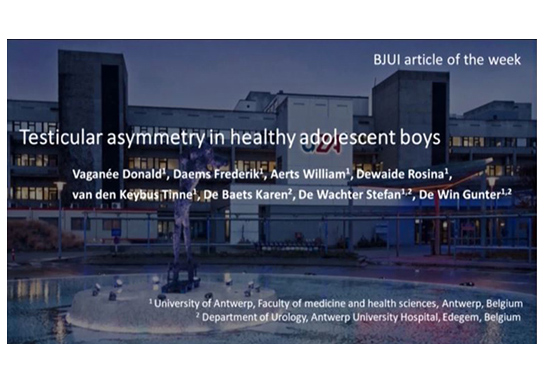Video: Testicular asymmetry in healthy adolescent boys
Testicular asymmetry in healthy adolescent boys
Abstract
Objectives
To assess the presence of testicular asymmetry and the currently used threshold values in varicocoele management in a healthy adolescent population.
Subjects and Methods
We conducted an observational cross‐sectional study from April 2015 until December 2016 in which we recruited 539 adolescent boys aged 11–16 years. A clinical examination including testicular size measurement by ultrasonography was performed. Testicular volume (TV) was calculated using the Lambert formula (length × width × height × 0.71). The Testicular Atrophy Index (TAI) was calculated using the formula [(TV right – TV left)/largest TV] × 100. The data for all statistical analyses were stratified for Tanner stage for genital development (TSG) and pubic hair (TSP). Non‐parametric tests were used to assess the difference between right and left TV, and the prevalence of a smaller left testis for the entire population, and between each TSG and TSP. Parametric tests were used to determine the difference in mean TAI between each TSG and TSP, and to compare the mean TAI to a test value of 0.
Results
Of the 539 recruited boys, we excluded 194 due to a current or past pathology, including varicocoeles, influencing normal (testicular) growth or due to incomplete data. Most boys were in the second Tanner stage, followed by the third Tanner stage. The mean (sd) age of the entire population was 13.33 (1.25) years. Of the 345 included participants the mean (sd) left TV was 7.67 (5.63) mL and right TV was 7.97 (5.90) mL. The mean (sd) TAI was 2.85 (17.00)%. In all, 203 (58.84%) boys had a smaller left testis and 142 (41.16%) had a smaller right testis. In all, 51 boys (14.78%) had a TAI >20%, 45 (13.04%) had a TV difference (TVD) of >2 mL with a deficit in left TV, and 69 (20.00)% had a TAI >20% or a TVD of >2 mL with a deficit in left TV. Related‐samples Wilcoxon signed‐rank test showed a significant difference in mean left and right TV for the entire population, and more specifically for TSG3 (P < 0.001) and TSP3 (P = 0.004). A one‐sample t‐test showed a significant difference in the mean TAI vs the test value of 0 for the entire population (P = 0.002), and more specifically for TSG3 (P < 0.001) and TSP3 (P = 0.003).
Conclusion
Testicular asymmetry, with a smaller left testis, was seen in a considerable number of healthy adolescents. One out of five adolescents had a smaller left testis and met one of the threshold values currently used in varicocoele management. Therefore, in left‐sided unilateral inguinoscrotal pathology, a smaller ipsilateral testis in combination with a TAI of >20% and/or TVD of >2 mL requires careful interpretation and serial measurements of TV should always be performed. Furthermore, this study provides reference values for TV, TVD and TAI according to TSG and TSP for a healthy adolescent population.

